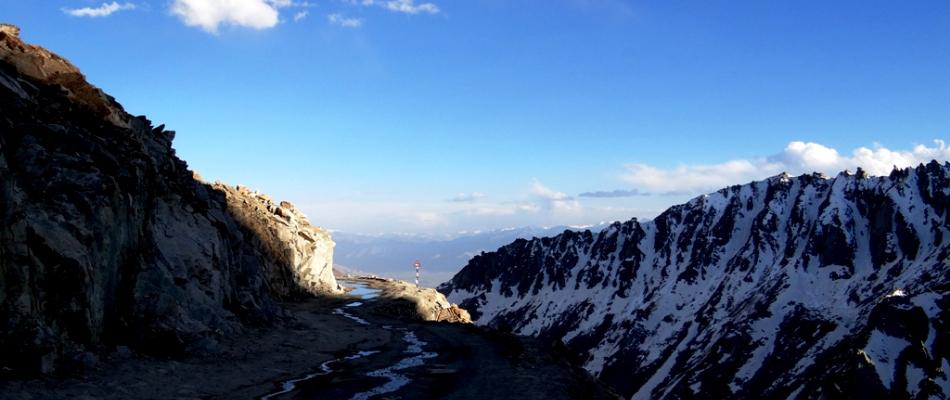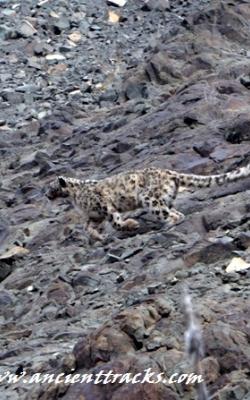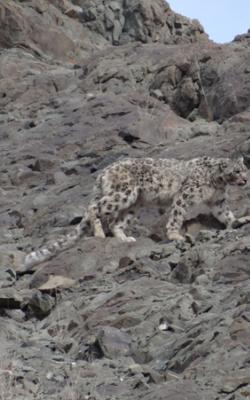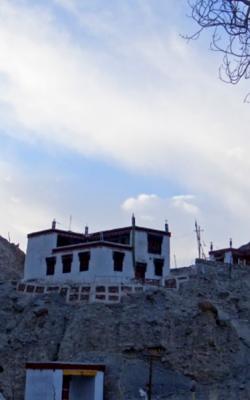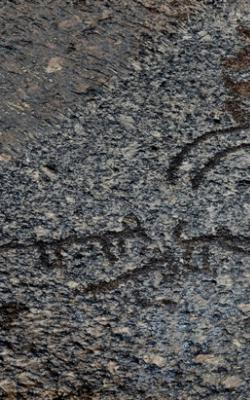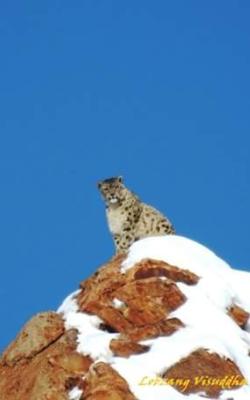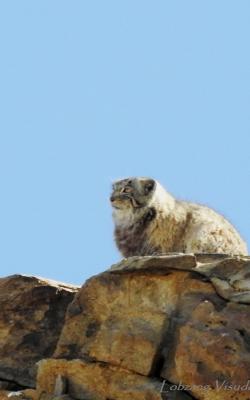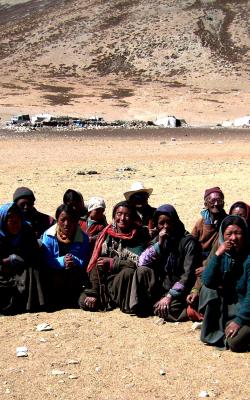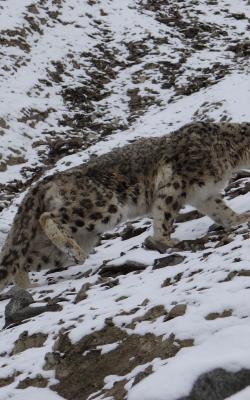Travelling to Ladakh?
Travelling to Ladakh is a unique experience. Ladakh unlike many other popular tourist destinations, need much more care in planning a trip. Ladakh can be reach both by flights and by road from plain Indian States of Himachal Pradesh and Jammu and Kashmir. Leh can be reached by flight from Delhi (daily flights), Chandigarh (weekly twice), Jammu (weekly twice) and Srinagar (daily in summer). In the peak touris summer months ( May end till Oct) Leh can be reach by roads, via Manali and Srinagar. Normally these journeys takes minimum two days. But some overnight taxi and tempo services take you to Leh in 18-20 hrs. The road journeys to Ladakh are hard and takes much more time than any travelling in any other parts of the world. This is due to high mountain passes and zigzag mountainious loopy and curvy roads. But the great nutural spectacular sceneries on such journey to Ladakh are a treat to the diserning eyes.
Leh being situated at an elevation of 3500 m above sea level needs better planning and aclimitization space - a must for every traveller reaching Leh by flight. Following Travelling Information and TravellingTips might be useful specially for adventure tourist - hardcore trekkers and mountaineers:
PROTECTED AREA PERMIT (PAP) REQUIREMENTS
Application can be processed on arrival in Leh, Ladakh but it is always better to send documents in advance. Restricted Areas: Nubra Valley till Turtuk (Northern Ladakh), Pangong Lake, Pangong Tso, Tsomoriri / Korzok via Mahe Bridge, Nyoma till Loma Bend, Dha, Beama in Aryan Valley (Lower Indus or Western Ladakh). Permits for these areas can be obtained from Deputy Commissioner's office through a Govt. Registered Travel Agency in Leh on any working day. The Deputy commissioner Officer has graciously agreed to open for such permit on special or national holidays including Sundays during the tourist season. Turtuk and Pangong Lake via Shayok is newly opened PAP destinations in Ladakh, including the Nyoma and Loma Bend. For the Indian Citizens, with a special permit, a circular route from Pangong to Hanle or Anly via Chushul and Tsaga La pass. Foreigners cannot obtain such permit to Hanle/Anley. While procuring this permit, the Govt. collects Environtmental Fee of INR 400 (one time) along with Wildlife INR 20/day/person and Redcross fee/donations of INR 100/person.
NEW Rule: Solo Traveller need to have a local guide along with him/her and also get the permit stamped by ALTOA office. ALTOA is All Ladakh Tour Operators Association, responsible for vouching the integrity of the Travel Agents in Ladakh.
Foreign Tourists Holding following Passport/Visa also cannot obtain the PAP permit from Leh:
Diplomat Passport or India Visa
Journalist Passport or India Visa
Documents required
- Application form needs to be filled and signed
- Photocopy of passport
- Photocopy of valid India Visa
- Minimum members: 02
- Maximum period of PAP: 7 days
Time Zones
India is five and a half hours ahead of Greenwich Mean Time
CURRENCY
In Leh, the capital town of Ladakh, where you will spend minimum 2-3 nights has the facility of foreign exchange and ample number of ATMs to withdraw Indian Rupees. Limit of such withdrawals depend on the card type you hold, should work in emergencies.
You won’t need to take a much cash on such trip, just enough for any souvenirs you may buy, drinks, and any meals that are not covered in the cost of the trip. Anywhere from Euro 500 to Euro1000 should be enough, depending on how much shopping you like to do, plus an amount for any tips you may want to give the camp staff or trip leader (see the Gratuities section).
ACCOMODATIONS
We use ‘A’ class hotels in Leh. All accommodation in small towns are in guest houses/ lodges and would be the best available in such places. Some places which do not have any staying facilities we’ll be using deluxe camps esp. at Sarchu, Pangong, Tsokar and Tsomoriri Lakes.
TIPS
It is customary in India to tip the staff members who are at your service for trip. We suggest each trip member tip about Euro 30 to Euro 70 towards the group tip, preferably in Indian rupees. This generally works out to be Euro 3 to Euro 5 per day per person.
Trip members also usually tip the group leader / guide. Typically, individual trip members tip the main guide Euro 100 to Euro 200, depending on the level of satisfaction and number of days of service. All tipping is, of course, at your own discretion and you are under no obligation to tip.
MOUNTAIN SICKNESS
High Altitude Mountain Sickness Trekking at High Altitude is very different from that at lower altitudes. If the trek is not well paced, or if the acclimatization is not complete, the trekker falls prey to high altitude sickness. High Altitude Sickness is not something related to one’s physical fitness. The main cause of altitude sickness is inability of persons to adapt to the reduction in the level of oxygen at high altitude.
Mild symptoms of high altitude sickness like lightheaded / headaches and breathlessness is common even among the locals of the area after a long stay in the plains. However, when accompanied with nausea, dizziness, severe cough, swelling of face/hands (due to water retention), and disorientation, medical treatment is sought.
Anyone with severe symptoms would be transferred to the hospital and kept under observation. The only cure for such cases is sending the patient on the next flight to the plains.
It is advisable for clients at high altitude to take it easy and rest for the first few days, which would help you in acclimatization. There is no medicine to cure High Altitude Sickness. Diamox has been used to help in acclimatization but it is advisable to consult your physician regarding it as side effects are there especially for those allergic to sulpha drugs. The best is to take plenty of water. Taking of alcohol is not advised at high altitude.
As long as one takes it easy and does not get too adventurous like trying the reach the highest point on arrival, mild symptom as mentioned earlier are common and not a cause for worry. Acclimatization is the best process.
The more serious conditions of High Altitude sickness are
- HAPE (High Altitude Pulmonary Edema)
- HACE (High Altitude Cerebral Edema)
Both these cases can be fatal in less than 24 hours if not diagnosed and treated in time. In both these cases, drugs like dexamethasone and Nifedepine (consult your doctor) are given to ease the symptoms but the ONLY cure is DESCENT, the patient needing immediate hospitalization and medical attention later.
HAPE – The symptoms are continuous headache with dizziness accompanied by racking cough (fluid in the lungs), loss of appetite. It commonly affects the un-acclimatized especially who venture too quickly into the high mountain regions.
HACE - It is swelling of the brain due to damage of brain tissues. The symptoms are headache, disorientation, irritability, and loss of appetite. HACE is rare but can be sudden and severe. Sudden collapse and death can happen within hours.
Swelling of face and hands is accompanied with the above symptoms. For the above serious conditions as mentioned earlier, the only answer is descent, descent, and descent
The other sickness can be
Snow blindness –caused by strong concentration of ultra violet rays at high altitudes. Though very painful, it is curable.
Sunburn – caused by reflection of ultra violet rays from the snow.
Frost Bite – freezing of skin and deeper tissues, occurs at temperatures below freezing and usually affects nose, ears, fingers, toes and feet. If immediate treatment is given, the individual may recover completely otherwise it may develop into blisters and gangrene depending on the severity of exposure.
TREKKING EQUIPMENTS
It is important to travel as light as possible and take only essentials. Domestic carriers allow up to 50lbs of luggage but on the trek there are limitations as your duffle is carried by a porter or pack animal so your trekking bag should weigh up to 40 lbs (including sleeping bag). While on trek your city clothes can be safely stored at the hotel (if you are returning) or handed over to agent to store until return from trek.
LUGGAGE
Duffle for gear for treks
Sturdy and water proof duffle bag – large enough to hold sleeping bag plus trekking clothes and gear. The bag can get dusty and can get tears as sometimes trails are narrow and pack animals, porters can scrape against cliffs hence the duffle should be sturdy.
DAY PACK REQUIREMENTS
Should have a capacity of 1500 to 2000cubic inches to carry camera, water bottle, light jacket and packed lunch. Can double up as carry bag on flight.
Spare roll up duffel: You should consider bringing a small, roll up nylon duffle (lockable) to store city clothes while on trip.
CLOTHINGS
This should be comfortable to protect you from cold (and possibly wet) weather. Synthetic clothing like polypropylene, capelin, pile are light in weight, wick away perspiration, dry quickly if wet and provide the best insulation against cold. Wool /synthetic blends are also suitable. Use of cotton in cold, wet mountain conditions is not recommended.
When layering in cold weather conditions, the innermost layer should be long thermals, the middle layer can be synthetic wool, fleece, outer layer can be down / synthetic jacket and in extreme conditions, good quality Gore-Tex wind / rain parkas over this.
Even though villagers in well trekked routes are used to seeing individual foreign trekkers in skimpy wear we would request our clients to be dress modestly. Women and men can both wear long, baggy hiking shorts, long trousers. Women should avoid “sports bra” tops.
Quantities for clothing are not included so you have to use your own judgment based on duration of trek, expected weather conditions and overall weight restrictions.
SLEEPING BAG
Medium weight, down or fiberfill rated from –5ºC (July / August) and rated –15ºC for September in Ladakh.
Sleeping bag liners – Lightweight fleece liners are great as to use in lower altitude treks and warm weather. Serves as an added layer for light weight sleeping bags.
UNDERWEAR
Regular underwear. Synthetics are easier to wash and dry
Thermal long underwear’s. Lightweight and medium weight tops and bottoms.
SHIRTS
Short sleeved T shirts (synthetic is best)
Long sleeved synthetic T shirts (especially is the late season)
SWEATER / JACKET
Heavy Down for autumn.
Medium weight fleece jacket, sweat shirt.
Medium weight / heavy weight down / synthetic filled jacket.
TROUSERS
Baggy hiking shorts
Long baggy trekking trousers / sweat pants
Lightweight / medium fleece pants to wear at higher camps.
HEADWEAR
Sun hat with wide brim and neck protection
Wool hat (autumn in Ladakh)
Bandanna. - Multipurpose to cover nose, mouth (dust), around neck for protection against sun, handkerchief, hand towel.
FOUL WEATHER GEAR
Gore-Tex rain / wind parka
Gore-Tex rain / wind pants with full length side zipper to fit over pants.
HAND WEAR
Polypro liner gloves
Wool /fleece mittens
SOCKS
We recommend 3 / 4 pairs of inner and outer socks
Athletic running socks
Synthetic inner socks
Mid weight hiking socks
FOOTWEAR
Sturdy, properly fitting footwear. If you are buying new boots, please break them in by wearing as much as possible before the trip.
Medium weight trekking boots (preferably water proof leather) with padded high ankle, good arch support. These should be good quality for prolonged walking on rocks, screes, boulders, snow.
Tennis shoes (serves as good spares) to be worn around camp – optional
1 pair Tevas (for rafting and very useful for river crossings wear around camp on trek). Must for Ladakh groups. Can be used on monastery sightseeing day – easy to put on and off
Sunglasses – dark especially for Ladakh where sunlight is very strong.
Chums / bands to hold glasses.
OTHER ITEMS
Hiking sticks – very helpful for the steep descents and ascents.
Swimsuit for pool at hotel (if there is one)
Set of casual city clothes which can be stored while on trek.
Water bottle – 1.5 litre capacities x 2 .Make sure these are leak proof, heavy duty plastic.
Toileteries: biodegradable soap, toothbrush, paste. Women should bring any feminine products or buy them at the last city before trek.
Small towel / gym washcloth is light, folds small so more practical
Body lotion
Sunscreen – min 25 SPF
Lip Protection
Personal medical kit
Money belt or neck pouch to store cash / passport.
Spare reading glasses, prescription glasses. (Contact lens not recommended for dusty trekking conditions)
Headlamp /flashlight with spare batteries
Disposable towelettes / baby wipes / hand sanitizers
Lighter (to burn toilet paper / paper napkins)
Plastic bag / zip lock bags of various sizes.
Heavy weight garbage bags to use as waterproof liner inside duffle.
Small padlocks
Camera and film
Repair kit with needle, thread, safety pins
Reading, writing material
Swiss army pocket knife
Powdered mixes such as Gatorade to flavor water.
Trail snacks
MEDICINE CHECKLIST
Aspirin
Antacids
Band-Aids
Throat lozenges
Moleskins
Small hand towel
Antiseptic cream
Antihistamines
Broad-spectrum antibiotics (We normally use Ciprofloxacin, Azythromycin and these are readily available over the counter in India)
Painkillers
Cetrizine (anti allergy)
Paracetamol
Diamox (if going above 3,000metres)
Tiniba (easily available in India)
Personal medication, if any
SOME COMMON AILMENTS TO TAKE CARE OF
Diarrhea, constipation, cough, cold, stomach infections.
Medicines are easily available over the counter at all chemist shops in India.
Please check with you physician for the appropriate dosage.
SAFETY
All the clients are physically evaluated before signing up for a trip. However there can still be cases where one can suffer from any of the sickness mentioned earlier. In cases like those the only cure is descent.
While on a trek in a remote area if any client suffers from altitude sickness or any other serious injury, the guide sends a runner to the nearest telephone/army post/road head to ask for help.
Emergency evacuation becomes necessary in the following cases:
- High Altitude Sickness – If the client suffers from High Altitude Sickness, he needs to be lowered immediately.
- Injury – In case the client is badly injured – broken bones/fractures or sickness like thrombolytic (blood clotting), paralysis, loss of eyesight – in these cases as well he needs to be evacuated/lowered immediately.
- In the above cases evacuation by a chopper/helicopter becomes necessary if the clients are in remote areas.
Clients are monitored and anyone with any symptoms of altitude sickness is not sent on the trek. If anyone is slightly ill in Leh a doctor is called and the person assessed. Visiting charges for doctors is Euro 20/ to Euro 30 per visit. If a client requires oxygen then instead of sending the person to the hospital ( where facilities are basic)he / she is kept in the hotel and Ancient Tracks supplies the oxygen at charges of Euro 40 per cylinder.
If the symptoms of altitude sickness persist then the person is sent to Delhi on the next flight. We ask clients to get in touch with their insurance company in such cases and explain the situation. No person with symptoms of altitude sickness is taken on a trek. It is the leader’s decision and anyone not well is sent back immediately with support staff.
SATELLITE PHONES
We cannot have satellite phones as these are not allowed in India. However we would expect the leader to have one to deal with emergencies.
CUSTOMS
Indian Airport and Port Authority customs operate in the same way as most major countries across the world. Note that you are not allowed to take Indian antiques out of the country unless they are replicas.

